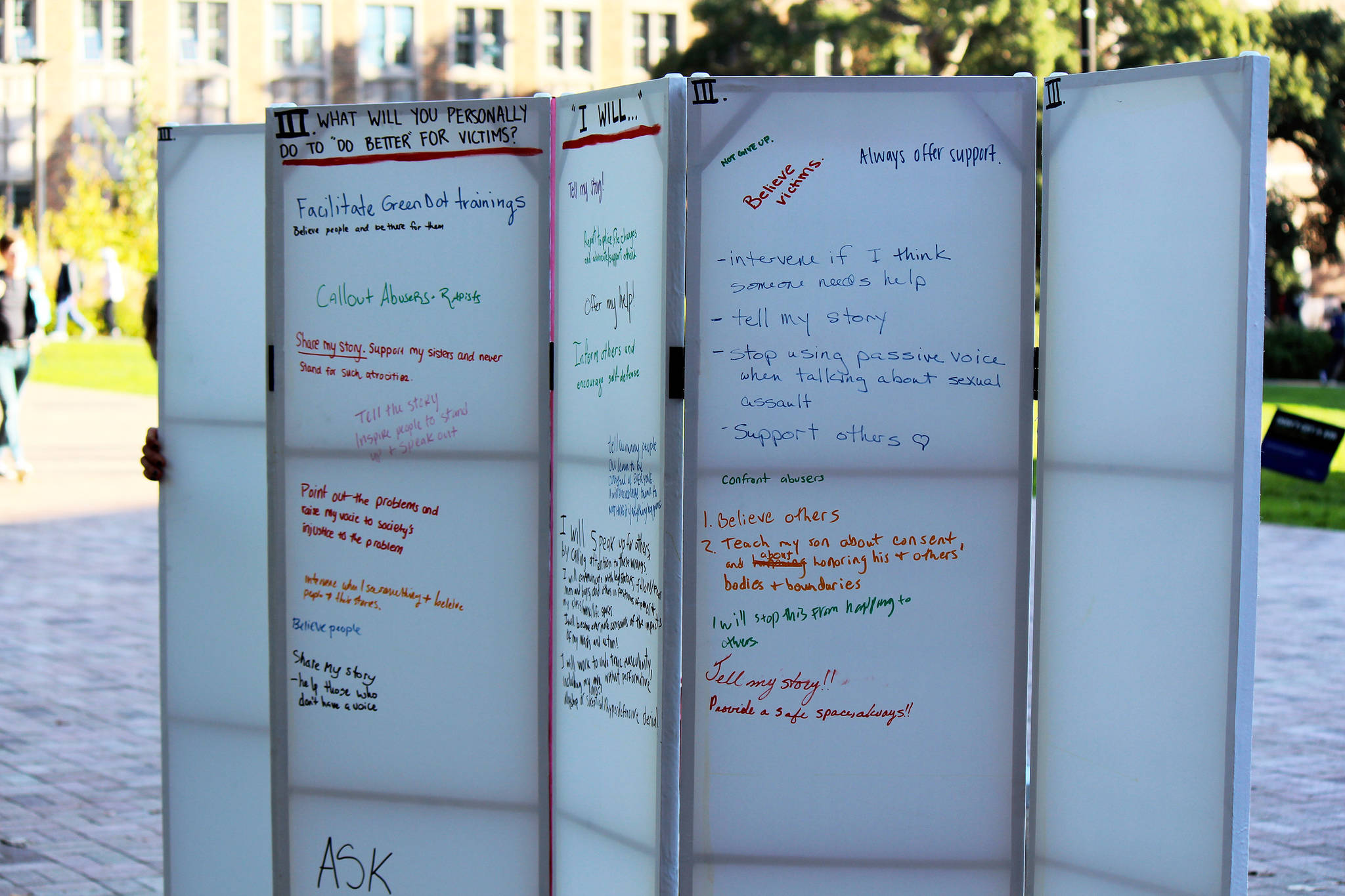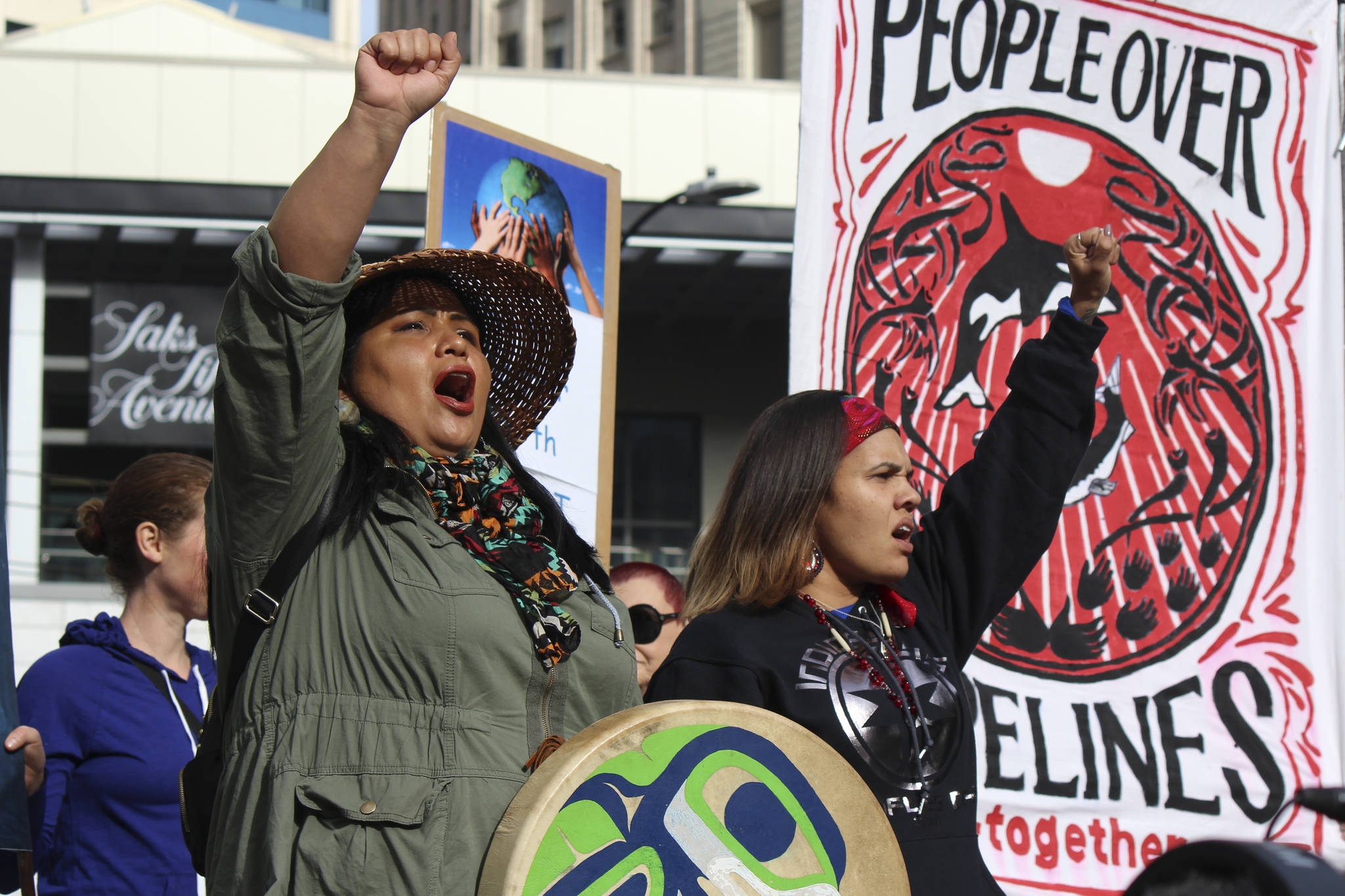Assistant teacher Dawn Hanson leads the class in a series of poses.
It’s a dreary day in mid-December, dark as flint and spitting cold rain. The Stafford Creek Corrections Center, near Aberdeen, rises neatly from the gloom like a well-manicured high-school campus. Its dozen or so concrete buildings, in various shades of gray and pale beige, are connected by long, wide sidewalks and clipped grass. The only discernible differences between a school and this prison—from the outside, anyway—are the massive spools of razor wire circling the place, the TSA-style security regulating entry, and the occasional parade of men in khaki uniforms and chalk-white sneakers trudging through the drizzle.
Inside one of the buildings, behind several heavy doors, Laura Prudhomme and Dawn Hanson are seated with 10 inmates in a small classroom. It has dull linoleum floors, fluorescent lights, and a few slim windows through which no daylight penetrates. A muffled voice issues commands through a loudspeaker somewhere nearby; a guard in a puffy jacket, then a khaki-clad inmate towing a mop and bucket, pass by along the hallway, visible through the panes of glass that line one classroom wall.
But in here, all that seems a world away. This class, like all yoga classes, starts with the breath. Prudhomme instructs the students to part their lips just barely. “Breathe through your mouth as if you were trying to fog up a mirror,” she says. “Inhale . . . exhale. Your breath comes like a sigh. It’s like the wind. It’s audible.”
Wendall Adams, 29, sits at one side of the room, very still, fingers interwoven, forearms on his thighs. He’s a former fitness trainer from Seattle with a physique that shows it: He’s muscular and poised, with faded tattoos on the backs of his hands and arms, a trimmed beard, and an eager face. During a break, Washington Department of Corrections communications director Jeremy Barclay—also a guest in the classroom today—greets Adams with a smile. “I haven’t seen you in a while, Wendall,” he says. “How are you?” Adams grins back, warm and emphatic: “Oh, evolving,” he says. “Just evolving.”
At Prudhomme’s direction, everyone sits cross-legged on their yoga mats, eyelids lowered, to begin a few minutes of meditation. Silence falls immediately; just the gentle whirr of the building’s heating system fills the room.
In a typical yoga class, Prudhomme says, when a teacher tells students to meditate, there’s a lot of shuffling and squirming as people struggle to get comfortable enough to concentrate. “But these guys? They drop in like monks.”
Yoga Behind Bars lead teacher Laura Prudhomme explains a technique to the inmates-in-training.
Yoga Behind Bars, a nonprofit based in Seattle, has been offering yoga and meditation classes in Washington’s prisons and juvenile detention centers since 2008. But the class at Stafford Creek Corrections Center is different. It’s the first to train inmates to be yoga teachers themselves. It’s also the first program of its kind in the country—and a partial inspiration for a few other, similar programs that have begun since, including one through the Portland-based Daya Foundation.
It began when Yoga Behind Bars executive director Rosa Vissers gave a TEDx talk at Monroe Correctional Complex in 2014. Afterward, feeling courageous, she approached now-Secretary of Corrections Dan Pacholke to ask if he thought she might ever be able to launch a teacher-training program. “Yes,” he replied. “You write a proposal and we’ll see what we can do.”
As these things go, then, it happened relatively quickly: The Yoga Behind Bars staff sent the Department of Corrections a proposal, it was swiftly approved, and last spring a few dozen inmates from across Washington’s prison system sent Yoga Behind Bars written applications—mostly lengthy, sincere essays about their own yoga practice or why they’d be interested in this opportunity. YBB and the DOC ultimately selected 10 men from five facilities across the state, based on their interest in mentoring others, their commitment to the practice—even if they didn’t have a lot of direct experience with yoga—and a record of good behavior in prison.
The DOC transferred them all to Stafford Creek last summer for six months of intensive training that started on August 15. The students participate in an in-person classroom session with Laura Prudhomme and Dawn Hanson one weekend a month; in between they study on their own, completing assignments and asking questions through a phone line and P.O. box that connect them to Yoga Behind Bars staffers. Graduation is in February; after that, the DOC will send students back to their facilities, where they’ll continue to train as assistants in YBB classes for another six to 12 months.
The first cohort is male, says Vissers, because there are simply more men behind bars: In Washington state prisons, men make up a staggering 92.5 percent of inmates. One day, YBB staffers would like to expand the program to women’s prisons, too.
Some of these 10 men have been studying yoga for years; some have just begun. Some are lean and supple; others flushed and straining. Some are in their 60s, others in their 20s. But they’ve at least one thing in common: They’ve got time. Most have very long sentences, and some are in for life, or life without parole.
That was not an accident. When developing the program with Yoga Behind Bars, the Department of Corrections didn’t envision it to be about job training or personal rehabilitation so much as a way to improve prison culture across the state. Inmates who studied yoga extensively and who taught yoga classes could serve as mentors to and conflict mediators for other inmates. From the DOC’s point of view, keeping those mentors around for a long time would help build trust, compassion, and institutional memory.
For Yoga Behind Bars, training inmates as teachers could also be a way to expand inmate access to yoga, period; a teacher-training program “has been a big dream of ours” for a long time, says Vissers. Many inmates who have taken YBB classes have become so committed to the practice that it felt important to offer them “the next step.” But fundamentally, she says, it’s about transforming the criminal-justice system from within—and reducing the number of people behind bars, one of the organization’s main tenets. It does so, or at least hopes to, by helping people to heal before they return to their communities.
And when it comes to healing, the incarcerated know best how to help the incarcerated. “I’ve been to a lot of prisons, but I don’t know what it’s like to be locked up,” says Vissers. “I can imagine, but I don’t know. People who are incarcerated need to be the leaders in changing the current system.”
There are about 2.3 million incarcerated people in the United States, including about 31,000 in Washington’s prisons and jails. The U.S. puts more people in prison than any other country in the world; though less than five percent of the world’s population, it houses 25 percent of its prisoners. And while no one, least of all Vissers, wants to negate crime victims’ need for justice—or society’s need for safer streets—mass incarceration has not improved crime rates very much. Recidivism is sky-high. According to a recent study from the Bureau of Justice, 76.6 percent of offenders released from state prisons in 30 states were arrested again within five years.
“Often we’re using incarceration as a solution to other societal problems,” says Vissers—poverty, racism, mental illness, homelessness. “There are people that are in prison that shouldn’t be. I don’t want to gloss over the fact that we have murderers, people selling drugs—people who have done stuff. I am aware of that. But then do we just punish, punish, punish and expect a different outcome the next time they’re out? How do we make sure that it doesn’t happen again? Yeah, locking people up for the rest of their lives would be a strategy, but it’s not working very well.”
Yoga isn’t some kind of amenity in prison, she adds. “It’s not a luxury for our students. It’s really something that they draw on and lean into the rest of the week. This is what I hear all the time.” One student told her, for instance, that he believed that if he’d found yoga before prison, he wouldn’t have ended up there at all, because there’s no way he could ever hurt another human being now the way that he did then.
“Yoga is the vehicle” of the work her organization does, says Vissers, “not the end goal. We’re teaching human beings. We’re not teaching poses.”
Wendall Adams is friendly and buoyant. He tells me he has another 10 years on the inside, and the reason he’s in prison has a lot to do with gangs and guns. “I got into gun violence. I was hanging with bad people,” he says. “This”—gesturing around the room—“helps me find my purpose. I want to work on social justice. I want to give back to the community,” his community, in Seattle. “They don’t have anything to hold onto. They’ve gotta know they don’t want to end up in here.” And then, in a low voice, “It’s horrible in here.”
He’s digging into that horror—that and everything else—in part through body and breath. “There are some poses that make me angry,” he says. “I try to lean into those.”
The trainees in this classroom are supportive of one another, respectful and gentle. They laugh a lot. One man, wearing a necklace of Hindu prayer beads, gives a fellow student’s shoulder a friendly squeeze as he passes by on his way to the bathroom. Another two bump fists after one helps the other with a Sanskrit word. The men practice poses, then read aloud from the thick Yoga Behind Bars workbook, which has two words printed on the back, big and bold: “Freedom Within.” They discuss each type of pose and its health benefits, as well as the impact it could have on their students, who will—for a very long time, anyway—be inmates, too. When discussing shoulder stands and the risk of neck injury for people with neck and back problems, one inmate points out that “a lot of guys are going to have that in prison because of our sleeping arrangements.” When figuring out how to describe each pose, they often compare it to weightlifting—keep your neck stationary, keep your stance wide—because “a lot of people lift weights in here.”
The class breaks up into two groups of five, with one student leading the rest in a series of poses, then receiving feedback from the other four. Yukio, a small-statured man with a thick black ponytail, is what the other inmates call “a short-timer,” since he’s got only six years left. He takes his turn leading the group, and everyone praises his soothing, yogi-like voice. Prudhomme offers him just one criticism: “You can be more direct. You know what you’re doing.” But the hesitation, Adams tells Prudhomme, “comes from our life in here.”
Yukio nods. Re-learning how to be in charge is tough. “I’m used to being told a directive,” he says, “rather than me giving a directive.”
But yoga, Yukio tells me afterward, has been vital for him. “It helps me do time a lot better. Being in prison causes so much stress and anxiety, of course . . . being away from your friends and family, having to deal with other inmates, who are dealing with their own problems.” If yoga and meditation has had any tangible effect on him, “it’s recognizing when I’m overreacting.” It has helped reduce conflict. And he too believes that inmates teaching yoga to other inmates will be a powerful thing. “Someone coming in off the streets, it’s so fundamentally different. [An inmate teacher would] know the problems we have to deal with”—so much so that sometimes, he says, they might not have to use words at all.
“We’re a team,” says Prudhomme. “We’re definitely a team. And every single weekend I’m getting schooled,” she adds, laughing. “Because they’re just so smart. They’re so invested and so committed. And just so hungry for it. I think that time and a lot of self-reflection will do that to you.”
Trainee Steven Bauder, tall and athletic with a light-brown goatee, says he’s been in prison since 2008, and has 18 years left on his sentence. His crime, documented by reporter Nina Shapiro in a Seattle Weekly cover story (“Streetwise He Wasn’t,” Nov. 10, 2010), was participating in the brutal murder of 25-year-old Noel Lopez, a young man who’d fallen afoul of the Seattle street-kid culture that Bauder and his accomplice belonged to. Shapiro attended Bauder’s sentencing in 2011 and reported that he seemed anguished; he held his head in his hands, spoke in a low croak, and told the judge, “I request the maximum sentence be imposed.”
Today, Bauder says he has been practicing the physical side of yoga for seven years—since he entered prison, more or less—just by looking through books and trying to find the most challenging poses. More recently, he began to take up the more spiritual side of things: meditation, mindfulness, the philosophy of yoga. And that’s sparked a huge transformation. “We’re so interconnected,” he says, gesturing toward a classmate, then around the room. “If I’m hurting him, I’m hurting myself. And I’m hurting you, and I’m hurting all of us.” Bauder’s total sentence, once served, will be 26 years and eight months.
“Having as much time as I do, I’ve had to reevaluate everything I was doing,” he says. And now, “I feel freer in here than I did on the street.”
To a lot of people, the men and women behind bars are a forgotten population, says Prudhomme, who’s been teaching with Yoga Behind Bars for eight years. Prisons aren’t in full view, usually—by design. If you don’t have cause to visit the downtown Seattle jail, for instance, chances are you might not know there was a downtown Seattle jail. And most prisons, particularly maximum-security prisons, are located in remote areas. “Out of sight, out of mind,” she says. “For that reason the stories about them can get really nightmarish.”
Yet working on things like trust, vulnerability, spirituality, and compassion with people in prison has transformed Prudhomme’s socially conditioned notions of what a prison is. “To interact with people who are considered ‘threats to society’ . . . you’re just like, ‘This person is exactly like me.’ ” Maybe they’ve made some different choices, sure—or one different choice—but they’ve got “the same fears and anxieties and struggles. The same work has to be done.”
Wendall Adams, for one, seems bound and determined to do that work. He says he’s in the middle of drafting a proposal for a nonprofit called The Peace Project, an effort to stem gang violence and offer support and opportunity for young men, especially black men. He’ll send it to the Seattle chapter of the NAACP as soon as he’s finished. He’s already written his “first” book, he says—a memoir. He wants to start his own yoga studio when he gets out, too; he’s been talking to his sister about that. He wants very badly to help people, to change things in the neighborhood he came from. He speaks eagerly, hopefully, in an upbeat, just-around-the-corner tone that belies the long decade he has remaining behind bars.
“I agree about wanting to make right what’s wrong, and honoring the victims of crimes,” says Rosa Vissers. “And if we really want to prevent these things from happening, we need to be doing something different than what we’ve been doing. I think this is one way.”
Sara Bernard writes about environment and education for Seattle Weekly. She can be reached at sbernard@seattleweekly.com or 206-467-4370. Follow her on Twitter at @saralacy.








